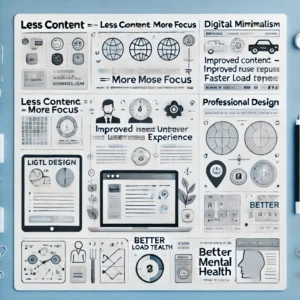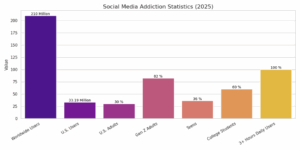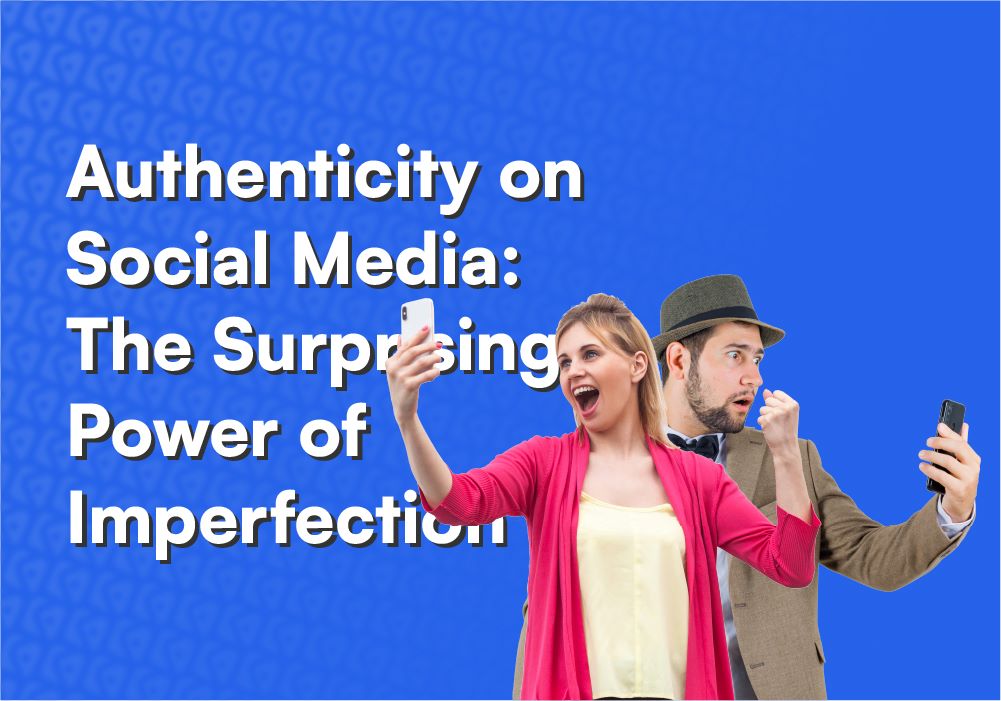Hvorfor digital minimalisme betyder noget i content marketing
indholdsmarkedsføring giver virksomheder mulighed for at opbygge og opretholde langvarige relationer. I moderne markedsføringsstrategier spiller content marketing en nøglerolle. Inden for dette felt er digital minimalisme især vigtigt i webdesign. Fokus er på det, der virkelig betyder noget: klarhed, funktionalitet og enkelhed. Ved at bruge hvidt rum, subtile farver og rene linjer bliver indholdet fremhævet – uden visuelle forstyrrelser.

Fordelene ved digital minimalisme
Digital minimalisme tilbyder en række fordele. En vigtig fordel er, at minimalistiske hjemmesider, med deres rene layout, er mindre forstyrrende for besøgende. Som et resultat kan brugerne finde vigtig information hurtigere.
- Professionelt billede Minimalistiske hjemmesider virker ofte langt mere professionelle for internetbrugere end dem, der er overfyldte med kaos og rod.
- Forenklet Kommunikation: Disse hjemmesider har typisk en enkel struktur med minimalt tekstindhold, hvilket gør dem lettere at navigere og forstå.
- Forbedret mental sundhed: At bruge mindre tid foran skærme betyder mindre stress og mental overbelastning. Overdreven brug af sociale medier og konstante notifikationer kan føre til angst og endda depression. Digital minimalisme hjælper med at modvirke disse negative effekter.
- Det er tid til at fokusere på det, der betyder noget: Ved at skære unødvendige digitale aktiviteter væk får du mere tid til personlige interesser, hobbyer og øjeblikke i det virkelige liv – så du kan fokusere på det, der virkelig betyder noget.
- Fokus over konstant stress: Løbende afbrydelser fra utallige notifikationer fører til kronisk stress. Med færre forstyrrelser bliver det lettere at holde fokus og bevare mental klarhed.
White Space Works – Hvordan digital minimalisme og minimalistisk design holder brugerne engagerede
Minimalistiske hjemmesider skiller sig ud med klar struktur, intuitiv navigation og et design, der kun fremhæver det, der virkelig betyder noget. Generøse mængder af hvidt rum, subtile farver og strategisk placeret indhold skaber en rolig, indbydende atmosfære, hvor besøgende nyder at bruge tid. I stedet for at blive overvældet af flashy bannere eller rodede menuer, bliver brugerne straks tiltrukket af det, der virkelig betyder noget: indholdet.
Denne bevidste reduktion—kerne i filosofien om digital minimalisme—forbedrer ikke kun brugervenligheden, men opbygger også tillid til dit brand. I en æra med digital overstimulering bliver “mindre” i stigende grad set som et tegn på kvalitet. Slow Media indkapsler dette princip—skaber digitale rum med klarhed, dybde og en stærk følelse af formål.
Ulempen ved indholdsoverload
Overdrevent brug af sociale medier kan have afhængighedsskabende virkninger på hjernen—sammenlignelige med stoffer som alkohol, cigaretter eller andre rusmidler. I nogle tilfælde kan det endda udløse symptomer på depression, angst og stress, sammen med andre alvorlige lidelser. På arbejdspladsen inkluderer de almindelige bivirkninger konflikter med kolleger og en mærkbar mangel på opmærksomhed forårsaget af mental træthed.

Praktiske fordele ved mindre indhold
- Mere fokus for brugere: Mindre indhold betyder færre forstyrrelser. Når indholdet er bevidst reduceret og tydeligt struktureret, har besøgende lettere ved at fokusere på det, der betyder noget. I stedet for at kæmpe sig gennem unødvendig tekst, grafik eller menuer, kan de hurtigt finde det, de leder efter—det øger både tilfredsheden og tiden, de bruger på dit site.
- Større effektivitet for skabere og brands: Reduktion af indhold er ikke kun brugervenligt, men også ressourceeffektivt. Færre stykker indhold betyder mindre produktionsindsats, lavere vedligeholdelsesomkostninger og en mere strømlinet redaktionel proces. Brands kan fokusere på kernebudskaber, kommunikere dem tydeligere og prioritere kvalitet over kvantitet.
- Hurtigere indlæsningstider og bedre ydeevne: Set fra et teknisk synspunkt giver mindre indhold klare fordele. Minimalistiske hjemmesider indlæses hurtigere og bruger mindre data—især vigtigt for mobile brugere. Det forbedrer ikke kun brugeroplevelsen, men påvirker også SEO-rangeringer og konverteringsrater positivt. I en digital verden, hvor hastighed er afgørende, digital minimalisme bliver en nøglefordel.

Strategier for “Slow Media” i praksis
Slow Media handler om at sænke tempoet for medieforbrug og -produktion i informationsalderen.
At finde det rigtige tidspunkt for opslag:
Definér tydeligt din målgruppe, og undersøg derefter online for at finde det ideelle tidspunkt at nå dem på. Udgiv dit indhold på forskellige tidspunkter for at teste effektiviteten. Slow Media handler også om bæredygtighed—med henvisning til de ressourcer, processer og arbejdsforhold, der er involveret i medieproduktion. Udnyttelse, lavtlønssektorer og den betingelsesløse kommercialisering af brugerdata stemmer ikke overens med bæredygtige mediepraksisser.
Hvis du vil lære mere om cindholdsforskelle, klik her: Contentforskelle på Populære Sociale Medier
Historiefortælling i en reduceret form:
Historiefortælling er en kernekomponent i content marketing. Selvom brugere generelt nyder at læse eller høre historier, er det vigtigt at reducere både længden og kompleksiteten for at bevare opmærksomheden og klarheden.
Brug af pauser som en del af strategien:
Pauser kan være et værdifuldt element i Slow Media-tilgangen. De giver mulighed for opmærksom afstand, støtter fokuseret forbrug og forstærker effekten af dit indhold.
Eksempler på succesfulde minimalistiske strategier:
Velkendte mærker som Apple, Medium og Notion stoler med succes på minimalistisk design, klart budskab og fokuseret indhold— hvilket fører til stærk brandgenkendelse og brugerloyalitet.
Risici og begrænsninger ved digital minimalisme
Når “For lidt” bliver kontraproduktivt
Du kan opnå større klarhed, fokus og effekt med mindre indhold. Men når digital minimalisme tages for langt—som at tilbyde for lidt information, ingen kontaktmuligheder eller manglende navigation—forbedrer det ikke længere brugeroplevelsen, men skaber i stedet forvirring og frustration. Det oprindelige mål om forbedret brugervenlighed går derefter tabt.
Afbalancering af synlighed og eksklusivitet
Digital minimalisme betyder ikke at forsvinde fra digitale rum. Hvis du reducerer eller publicerer indhold mindre hyppigt, skal du stadig forblive synlig—især over for din målgruppe. Overdreven eksklusiv eller svær at få adgang til kommunikation kan virke afkoblet eller uappellerende. Derfor er det vigtigt at kombinere reduktion med relevans: færre, men højtkvalitets, veltimede opslag på de rigtige kanaler. Synlighed handler ikke om konstant tilstedeværelse—det handler om at levere strategiske, effektfulde impulser uden at overvælde.
Fordele ved Slow Media
Fysisk kvalitet:
Slow Media er kendetegnet ved sin produktionsværdi, udseende og æstetisk inspirerende design, alle holdt til høje standarder. Det lægger vægt på kvalitet ikke kun i skabelsen af medieindhold, men også i dets modtagelse. Efterhånden som adgangen til information øges, bliver kulturelle færdigheder som kildekritik, klassificering og vurdering af informationskilder vigtigere.
Organisk distribution:
Slow Media spreder sig primært gennem anbefalinger i stedet for reklamer. Dens succes afhænger ikke af overvældende salgsfremmende pres på alle kanaler, men af mund-til-mund—via venner, kolleger eller familie. En bog, der bliver givet væk fem gange til nære venner, er et godt eksempel.
Kontrolleret hastighed:
Slow Media er progressivt, ikke reaktionært. Det bygger på teknologiske fremskridt og netværkssamfundets livsstil. Kun acceleration af mange områder af livet har gjort bevidst langsomhed mulig—og nødvendig. Slow Media er ikke i opposition til hastigheden og simultaniteten på Twitter, blogs eller sociale netværk; snarere repræsenterer det en tankegang og en bevidst måde at engagere sig i disse platforme på.
Konklusion
Digital minimalisme er langt mere end en æstetisk trend—det er en bevidst holdning til digitalt indhold, teknologier og kommunikation. Og mindre indhold betyder ikke mindre indflydelse. Faktisk kan det føre til større klarhed og fokus, stærkere brand-tillid, forbedret brugeroplevelse og bedre mental velvære.
Dette princip afspejles i Slow Media-bevægelsen. Det står for bevidst langsommere tempo i den digitale verden, hvor kvalitet, dybde og kulturel mangfoldighed prioriteres over masse, hastighed og overfladisk tilstedeværelse. Slow Media handler ikke om at afvise digitale teknologier, men om at bruge dem bevidst og bæredygtigt. Indhold offentliggøres med intention, substans og impact – i ånden af kontrolleret digital kommunikation.
De, der anvender digital reduktion strategisk, kommunikerer ikke mindre – de kommunikerer mere bevidst, mere meningsfuldt og med større resonans.


